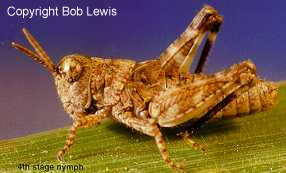Nymph description 4 of 15

Distribution

Nymph Description: Colour can be brown to green. From above the thorax has fairly distinct 'X' mark, more prominent than on adults. The rear femur has distinct bands, from above seen as 3 dark and 3 light. From the side the bands are at an oblique angle across the femur. The rear tibia are completely dark in early instars and light in later ones. Antennae are short, from the side about one to one and a half times the upright length of the eye. From the side the head and thorax show a light triangular shaped pattern among the general mottling. This species can form bands.
Confusion with Australian plague locust: Sometimes forms bands, similar shape and with an 'X' mark on top of thorax..
Confusion with other species of Austroicetes: Similar in most respects.Unique features: The combination of the 'X' mark with the bands on the rear femur being at an oblique angle,short antennae, and the shank either wholly dark or light. The plague locust has femur bands at a 90 degree angle, longer antennae, a light band at the top of the tibia and is larger. It is difficult to pick the difference between A. cruciata nymphs and other species in this genus. However, A. cruciata has a limited distribution and is the only species in this genus to commonly form bands.
Further information on this species: Description of adult
| Previous species | Next species |
